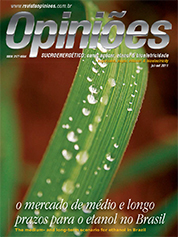Igor Montenegro Celestino Otto
Corporate Director of Grupo USJ
Op-AA-29
And now, Brazil, what is your dream?
In 2022, Brazil will commemorate 200 years of independence. What goal do we have for the sugarcane-based energy industry in this emblematic moment of our history? A goal is a dream with a date by when to occur. I believe that in the sugarcane-based energy industry our dream goal is to reach a production of 1.5 billion tons of sugarcane in 2022, and thus create thousands of jobs for our people, improve our economy and preserve our ecosystem. The 10-step recipe to reach this dream goal is achievable. Let’s go for it!
The first step is to reach the growth markets. Until 2022 we will be about 8 billion human beings on the planet. Therefore, there will be continuous growth in demand for energy, fuel and food in coming years. We must improve our marketing systems and warrant supply so that ethanol, sugar and bio-electricity may occupy the new markets that are being created in all regions of the planet.
The second step is to warrant business sustainability. To advance in improving safety and occupational health conditions in the sugarcane agro-industry. To disseminate best practices in agricultural management and in the re-utilization of residues. To invest in the maintenance of biodiversity.
To improve relations among companies and communities. To foster the integration of the production chain, increasing the participation of service providers and suppliers of the production process.
The third step is to attain economic-financial feasibility in undertaken projects. To reduce the financial cost of financing. To create new mechanisms for fiscal incentives for the activity. To reduce tax rates. To improve the parity of domestic ethanol prices and flexibilize the price of gasoline. To keep agricultural and industrial production costs under control.
The fourth step is to qualify professionals. To invest in people for activities in the production chain of the sugarcane agro-industry. To foster professional education in technical and technological schooling centers and in our universities. To assure good professional opportunities and good working conditions in companies.
The fifth step is to expand the agricultural area planted with sugarcane. To invest in the integration of the production chain made up of farmer and mill, providing competitive conditions for sugarcane suppliers. To share gains from economies of scale with partners in the production chain. To recover degraded agricultural areas due to grazing for planting sugarcane. To invest in the genetic improvement of varieties and in perfecting management of sugarcane agriculture.
The sixth step is to invest in the construction of new plants and to retrofit those already built. To build new plants with big processing capacities, high productivity technology and entailing the complete production mix (sugar, ethanol and bio-electricity). To invest in retrofitting existing mills, increasing their processing capacity, improving their productivity and completing their production mix.
The seventh step is to improve infrastructure and logistics. To build pipelines for transporting ethanol, connecting producer regions to the ports. To invest in perfecting waterways to transport sugar and ethanol. To conclude the execution of projected railroads. To improve the road network in production regions. To expand port infrastructure. To invest in the expansion of the electric power line network.
The eighth step is to focus on research, development and technological innovation. To invest in bio-technology seeking to increase agricultural productivity, to increase sugar content (Pol%), to improve fiber content, to reduce production cost and to diminish environmental impact of sugarcane-related activity. To invest in agricultural engineering innovation.
To invest in research and development concerning technological routes to hydrolysis and biomass thermo-conversion. To research new uses and new sugarcane products.
The ninth step is to improve business management. To invest in better corporate governance practices in publicly traded and closed capital companies. To apply advanced knowledge on strategic planning in companies. To disseminate a results-based management culture.
To develop leadership abilities. To utilize advanced information technology systems for business management. To develop corporate communication abilities and institutional relations.
The tenth step is to improve the institutional environment. To warrant a clear regulatory mark, establishing clear responsibilities for private initiative and government. To warrant the functioning of an ethanol storage program aimed at keeping up supply to the consumer. To warrant the legal security of entrepreneurs, especially as related to environmental and tax legislation.
In bygone times, Brazil dreamed of being the world’s biggest sugarcane producer and accomplished this. The country dreamed of being the planet’s main sugar producer and accomplished this. The country dreamed of producing ethanol – a renewable fuel to replace oil - and accomplished this. The country dreamed of being independent in terms of energy and accomplished this.
The country dreamed of having the cleanest energy matrix and accomplished this. In the course of its history, Brazil has had the competence to plan its future and to transform its plans into reality. And now Brazil, what is your dream for the sugarcane-based energy industry? Well, experience taught us that our future result will be the same size of our dream goal, because in the end it is “our dreams that secrete the future”.




